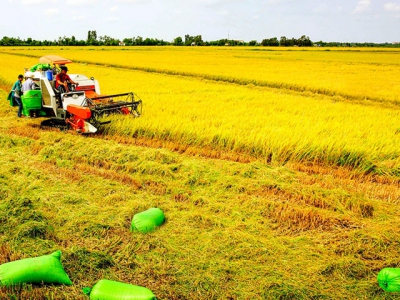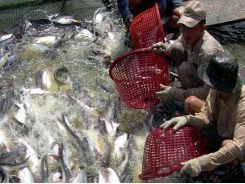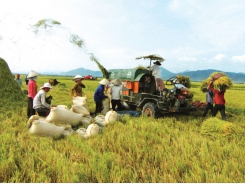Việt Nam aims to reduce greenhouse gas emissions in rice sector

HÀ NỘI — Agencies in Việt Nam and international partners have been working together to seek effective measures to reduce the emission of greenhouse gases in rice production in the country.
Farmers harvest rice in the Mekong River Delta region in Việt Nam. —VNA/VNS Photo
The Ministry of Agriculture and Rural Development last week held the first workshop on the implementation of Việt Nam's Nationally Determined Contribution (NDC) in the rice sector.
Aiming to set priorities for NDC implementation in rice production, the workshop highlighted different NDC scenarios to reduce greenhouse gas emissions while gaining economic, social, and environmental benefits sustainably.
The workshop was organised in collaboration with the International Rice Research Institute (IRRI), the Climate Technology Center and Network (CTCN) and the Climate and Clean Air Coalition (CCAC).
Representatives from the ministries and agencies involved in the planning and implementation of Việt Nam’s NDC, their partners and enterprises joined the workshop.
The rice sector plays an important role in agriculture and rural development, ensuring national food security, social security and affecting the livelihoods of many farmers. In Việt Nam, the rice sector has advantages in ecological conditions and it is associated with the country’s cultural values and heritages of a long-standing wet rice civilisation.
However, the rice sector in Việt Nam is facing challenges relating to low efficiency, resource intensiveness, environmental pollution and climate change.
According to the agriculture ministry, a project on restructuring the rice sector during the 2025-2030 period was approved early this year, and is expected to increase efficiency and ensure sustainable development for the industry.
Under the project, Việt Nam would implement measures to form and increase the efficiency of rice value chains, adapt and mitigate climate changes’ impacts, protect the environment, increase farmers’ income and consumers’ interests as well as export high-quality rice.
Việt Nam submitted an updated Nationally NDC in September 2020, increasing its commitment target level with high expectations for contributions from the agricultural sector.
IRRI had developed and analysed three scenarios for NDC implementation in the rice sector through changes in farming practices including the Alternate Wetting and Drying technology (AWD) or the Mid-season Drainage technique in the Red River and the Mekong River Deltas.
According to IRRI, the scenarios showed significant benefits of these technical packages, in particularly the reduction of GHG emissions, economic benefit for farmers and health and environmental benefits.
IRRI, CCAC, CTCN, UNIQUE Landuse - a German consulting firm and the Research Programme on Climate Change, Agriculture and Food Security developed a toolkit to support Việt Nam in making its NCD implementation plan.
These tools are: MapAWD – a mapping tool to identify suitable rice area for AWD application, SECTOR – a GHG emissions calculator specific for rice, and COMPARE – a cost-benefit analysis tool for mitigation options in rice cultivation.
The Department of Crops Production under the agriculture ministry took on a leading role in the formulation of the NDC implementation plan for the sector.
Through the workshop, department leader Nguyễn Như Cương acknowledged the proposed mitigation options to reduce GHG emissions in rice cultivation as well as the technical inputs by IRRI and workshop participants for building the NDC implementation plan.
He appreciated the contributions of IRRI and other organisations in providing technical assistance to MARD as well as linking partners and enterprises to achieve the goal of GHG emissions mitigation in Việt Nam's rice sector.
Có thể bạn quan tâm
Phần mềm

Phối trộn thức ăn chăn nuôi

Pha dung dịch thủy canh

Định mức cho tôm ăn

Phối trộn phân bón NPK

Xác định tỷ lệ tôm sống

Chuyển đổi đơn vị phân bón

Xác định công suất sục khí

Chuyển đổi đơn vị tôm

Tính diện tích nhà kính

Tính thể tích ao hồ



 Local fruit, vegetable businesses seek to meet global…
Local fruit, vegetable businesses seek to meet global…  Rice exports down in volume, up in price
Rice exports down in volume, up in price